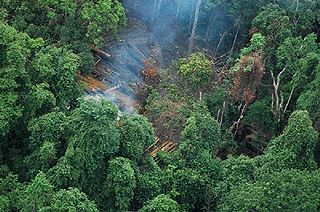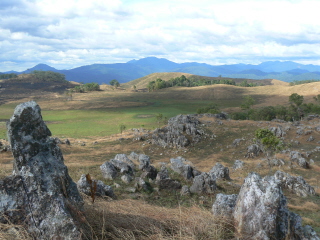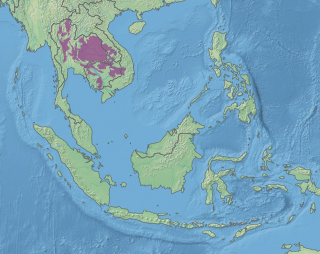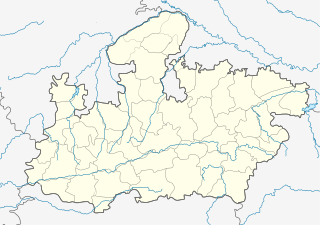
The white-shouldered ibis is a relatively large ibis species in the Threskiornithidae family. It is native to small regions of Southeast Asia, and is considered to be one of the most threatened bird species of this part of the continent.

The Krâvanh Mountains, literally the "Cardamom Mountains", is a mountain range in the south west of Cambodia and Eastern Thailand.

Dibru-Saikhowa National Park is a national park in Assam, India. It is located in Dibrugarh and Tinsukia districts and was designated a Biosphere Reserve in July 1997 with an area of 765 km2 (295 sq mi), including a core area of 340 km2 (130 sq mi) and a buffer zone of 425 km2 (164 sq mi).

Nawabganj Bird Sanctuary, renamed in 2015 Shahid Chandra Shekhar Azad Bird Sanctuary, is a bird sanctuary located in Unnao district on the Kanpur-Lucknow highway in Uttar Pradesh, India consisting of a lake and the surrounding environment. It is one of the many wetlands of Northern India. The sanctuary provides protection for 250 species of migratory birds mostly from CIS countries, but the numbers have been dwindling since the 1990s, most having relocated to newer areas in Himachal and Rajasthan. The sanctuary also houses a deer park, watchtowers and boats.

The wildlife of Cambodia is very diverse with a registered 212 mammal species, 536 bird species, 176 reptile species, 850 freshwater fish species, and 435 marine fish species. An unknown amount of species remains to be described by science, especially the insect group of butterflies and moths, collectively known as lepidopterans. Many of the species in the country, including several endemic ones, are recognized by the IUCN or World Conservation Union as threatened, endangered, or critically endangered due to deforestation and habitat destruction, poaching, the illegal wildlife trade, and farming, fishing, and forestry concessions. Intensive poaching may have already driven Cambodia's national animal, the kouprey, to extinction, and wild tigers, Eld's deer, wild water buffaloes and hog deer are at critically low numbers.

Lumphat is a district in Ratanakiri Province, north-east Cambodia. In 1998, it had a population of 10,301.

There are more than 2000 species of fauna that can be found in Tamil Nadu. This rich wildlife is attributed to the diverse relief features as well as favorable climate and vegetation in the Indian state. Recognizing the state's role in preserving the current environment, the government has established several wildlife and bird sanctuaries as well as national parks, which entail stringent protective measures. Tamil Nadu is also included in the International Network of Biosphere Reserves, which facilitates international recognition and additional funding. Currently, there are five national parks and 17 sanctuaries that serve as homes to the wildlife.

Virachey National Park is a national park in north-eastern Cambodia covering an area of 3,380.57 km2 (1,305.25 sq mi).
Ratanakiri Province in northeastern Cambodia is home to many species of animals. One 1996 survey of an area to the northwest of Lomphat Wildlife Sanctuary recorded 44 mammals, 76 birds, and 9 reptile species. The following is an incomplete list of species recorded in Ratanakiri.

Hastinapur Wildlife Sanctuary is a protected area in the Gangetic plains of Uttar Pradesh, India. It was established in 1986 and covers 2,073 km2 (800 sq mi) across Meerut, Muzzafarnagar, Ghaziabad, Bijnor,Meerut and Amroha districts.

Vedanthangal Bird Sanctuary is a 30-hectare (74-acre) protected area located in the Kancheepuram District and Madurantakam taluk of the state of Tamil Nadu, India. The sanctuary is about 75 kilometres (47 mi) from Chennai on National Highway 45 (NH45). Easily reachable from Madurantakam and Chengalpattu. More than 40,000 birds, from various parts of the world visit the sanctuary during the migratory season every year.

Boeng Tonle Chhmar is a 145.6 km2 (56.2 sq mi) large multiple use management area in Cambodia bordering Tonlé Sap lake that was established in 1999. It is located in Peam Bang Commune in Kampong Thom Province.

The Central Indochina dry forests are a large tropical and subtropical dry broadleaf forests ecoregion in Southeast Asia.
Jaipur Zoo is in the city of Jaipur in Rajasthan state in India. The zoo was opened in 1877 and is located near to the Albert Hall Museum and Ram Nivas Garden. It is divided into two parts: one for mammals and other for birds and reptiles. Nearly 50 species of different birds and animals from all over the world can be seen here. In year 1999, the ghariyal breeding farm is established which is fourth largest breeding farm in India. A museum was also constructed inside the zoo which exhibits the wildlife of Rajasthan. The Jaipur Zoo has been constituted under the Wild Life (Protection) Act. The main objective of the zoo is to complement the national effort in conservation of wild life. In 2018 it was announced that the zoo will be converted into a bird park with large aviaries. Large carnivores have already left the zoo.

Nauradehi Wildlife Sanctuary, covering about 1,197 km2 (462 sq mi), is the largest wildlife sanctuary of Madhya Pradesh state in India. This wildlife sanctuary is a part of 5500 km2 of forested landscape. It is located in the centre of the state covering parts of Sagar, Damoh, Narsinghpur, and Raisen Districts. It is about 90 km from Jabalpur and about 56 km from Sagar.
Nambor - Doigrung Wildlife Sanctuary is a Morangi located in Golaghat district of Assam in India. This wildlife sanctuary covers an area of 97.15 km2. It is located 25 km from Golaghat town and about 318 km from Guwahati LGBI Airport. The forest type is tropical semi-evergreen with pockets of pure evergreen, interspersed with small forest marshes. The area was declared as a Wildlife sanctuary in 2003. The sanctuary along with Garampani Wildlife Sanctuary and Nambor Wildlife Sanctuary (37 km2) are a part of the Kaziranga-Karbi Anglong Elephant Reserve, which was declared on 17 April 2003, with an estimated area of 3,270 km2.

Pani Dihing Wildlife Sanctuary is a 33.93-square-kilometre (13.10 sq mi) wildlife sanctuary located in Sivasagar district, Assam. It is 22 km (14 mi) away from Sivasagar town. This protected area was established as a Bird Sanctuary in August 1999 by the Government of Assam.

Stung Sen is a protected multiple use management area and wildlife sanctuary in the Kampong Thom Province of Cambodia. It is located near the south-eastern tip of the Tonlé Sap, one of three wildlife sanctuaries around the lake, including Boeng Tonlé Chhmar and Prek Toal.

The Aguacaliente Wildlife Sanctuary is a nature reserve in the Toledo District of southern Belize. It encompasses approximately 5,492 acres (22.23 km2) and was declared a sanctuary in 1998. The Sanctuary is critical for the preservation of biodiversity in Belize and the region. The National Park protects the central wetlands areas which consist of three fresh water lagoons and a hot-spring connected by a number of creeks hence the name Aguacaliente. It is co-managed by the Aguacaliente Management Team (AMT), a consortium of people from adjacent villages.


















